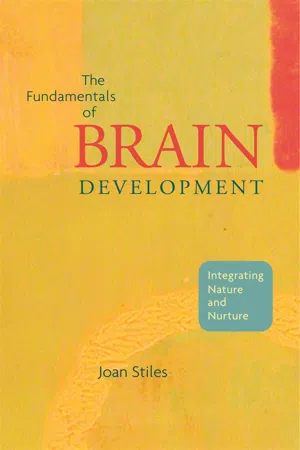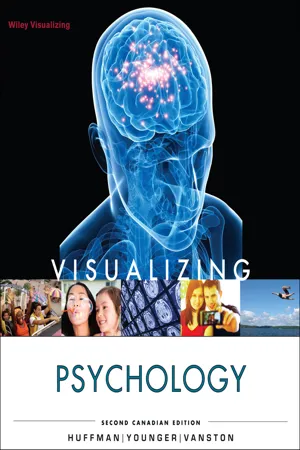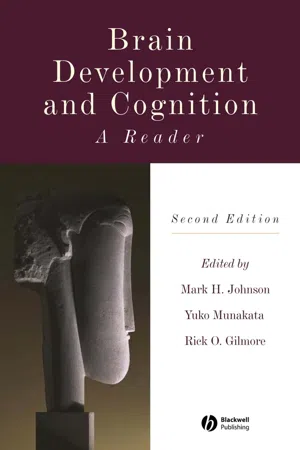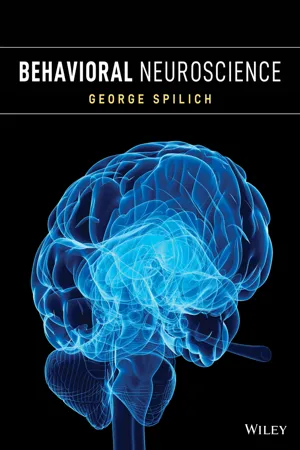Psychology
Brain Development
Brain development refers to the process through which the brain grows, forms connections, and undergoes changes over time. It encompasses the physical and cognitive changes that occur from infancy through adulthood, including the development of neural pathways, synaptic pruning, and the acquisition of cognitive skills. Factors such as genetics, environment, and experiences play crucial roles in shaping brain development.
Written by Perlego with AI-assistance
Related key terms
1 of 5
10 Key excerpts on "Brain Development"
- eBook - PDF
Developmental Neuropsychology
A Clinical Approach
- Vicki Anderson, Elisabeth Northam, Jacquie Wrennall(Authors)
- 2018(Publication Date)
- Routledge(Publisher)
Brain: the ‘bio’ dimension The brain can be identified quite early in gestation, with rapid development ongoing through infancy and childhood. In the prenatal period, development is largely concerned with structural formation, establishing the basic ‘hard- ware’ of the brain. Interruptions to Brain Development during this period have been shown to result primarily in structural abnormalities (e.g., dysplasia, neural tube defects, agenesis of the corpus callosum). In contrast, postnatal Nurturing + Stimulating Neglectful Abusive Risks + Weaknesses Resilience & Strengths Healthy Functioning Internalising Problems Anxiety •Somatisation •Depression •Psychosis Externalising Problems •Hyperactivity •Impulsivity •Aggression Environment Neurodevelopment Mental Health Outcomes Cognition Affect Stress Timing Repetition Psychosocial Context A biopsychosocial view Figure 1.3 A biopsychosocial framework for understanding child development (courtesy of J. Delio) Source: J. Delio, personal communication Child neuropsychology: theory and practice 11 11 development is largely directed towards elaboration of the brain, establishing the connectivity vital for the system to function effectively. This process of elab- oration continues into early adolescence, with the primary processes including dendritisation, synaptogenesis and myelination. It is generally thought that development occurs in a hierarchical manner, with anterior regions the last to reach maturity, in late puberty. While some controversy remains, there is support for a step-wise model of Brain Development, rather than a gradual or linear progression, with convergent evidence from both animal and human research that growth spurts occur in early infancy, again around 7–10 years of age, with a final spurt during early adolescence (Gogtay et al., 2004; Paus, 2005; Thompson, Giedd, Woods, MacDonald et al., 2000; Toga, Thompson, & Sowell, 2006). - eBook - PDF
The Fundamentals of Brain Development
Integrating Nature and Nurture
- Joan Stiles(Author)
- 2008(Publication Date)
- Harvard University Press(Publisher)
Timing is critical both for the moment-to-moment process of develop-ment and for the longer-term emergence of stable structures and func-tions, as well as for any influence external factors might have on devel-opment trajectories. The model of Brain Development presented here differs significantly from older maturational models in which systems emerge in a linear fashion. But this more dynamic model fits the growing body of data on Brain Development from the early embryonic period through postnatal development. The Importance of Brain Development for Psychology 383 The concept of Brain Development as a constrained and temporally bound but flexible and adaptive process has significant implications for psychologists. First, on the question of innateness, within this model of biological Brain Development, innate factors, that is, inher-ited factors, are inextricably linked to experience, and together inher-itance and experience define and direct the developmental process. This presents a very different view of what it means for something to be innate than is typically presented in psychological models. In this view, everything that develops has an innate aspect. It must because all de-velopmental processes rely, fundamentally, on the information en-coded in the genes and on the cellular mechanisms that provide access to that information. Genes themselves do not participate in develop-mental processes; rather, it is the products of gene expression, the pro-teins, that are the active agents in development. But gene products do not by themselves create neural structures or functions. Rather, they participate in complex signaling cascades that over time serve to direct the fate of cells, the organization of systems, and the establishment of signaling pathways. Indeed, the same gene product can have markedly different effects depending on the developmental context in which it is expressed. - eBook - PDF
The First Three Years and Beyond
Brain Development and Social Policy
- Edward F. Zigler, Matia Finn-Stevenson, Nancy W. Hall(Authors)
- 2008(Publication Date)
- Yale University Press(Publisher)
The studies are showing that Brain Development is not sim-ply a predictable biological process, nor is it entirely the result of a response to experience. Rather, it is an outcome of a bidirectional process in which both the genes and the environment interact. Underscoring the complexity of the process, William Greenough and James Black ( 1992 ) note that in Brain Development there are: ( 1 ) in-trinsic forces that provide the scaffolding essential for later develop-ment; ( 2 ) another kind of intrinsic force, evident in synapse overpro-duction (discussed later), that is designed to capture information from experience; and ( 3 ) a separate mechanism that is responsible for input from the experiences unique to each individual. They contend that in view of the existence of this latter mechanism, the quality of the child’s experiences is important, a point that will become evident in this as well as subsequent chapters. The Brain’s Structure and Organization Although the infant’s experiences after birth and their role in brain de-velopment have captured widespread interest in recent years, brain de-28 The Science of Brain Research The Science of Brain Research 29 velopment begins, and is subject to environmental influence, during the prenatal period. Before discussing this point, it is important that we review the structure and organization of the brain. Given the lim-ited scope of this chapter, our review is selective and is elaborated upon in subsequent chapters. Here we provide highlights of what is cur-rently known about how the brain is built. The brain is often described as looking rather like a very big wal-nut. It is made up of the forebrain (the upper cortex), and mid- and hindbrain (the subcortex), the latter of which is the brain stem. Con-necting the brain stem to the rest of the body is the spinal cord, which carries fibers from the brain to connect with muscles and organs in other parts of the body. - eBook - PDF
Mapping the Mind
The Intersection of Psychoanalysis and Neuroscience
- Fred M. Levin(Author)
- 2018(Publication Date)
- Routledge(Publisher)
Although few would argue that what is called psychological devel-opment occurs as a consequence of changes in the organization of the Changing Organization of the Brain -187 brain, there are differences of opinion within psychoanalysis regarding whether one needs to understand what these organizational changes consist of. Some believe that psychoanalysis can be practiced without any knowledge of mind/brain correlations whatsoever. However, a counter-argument (Trevarthen, 1979; Levin, 1980; Joseph, 1983, personal communication; Kandel, 1983; Reiser, 1984; Basch, 1979, 1985; Gunther, 1987; Schwartz, 1987; Levin, 1988) is that new knowledge of the brain, integrated into psychoanalytic theory, offers a special combination of insight and usefulness that enhances both psychoanalytic theory forma-tion and clinical practice. The validation of scientific theories also requires that they be tested, at times by means of interdisciplinary research. Development is difficult to comprehend because of its extraordi-nary complexity. There are many unanswered questions regarding how specific psychological milestones and the early development of the brain relate to each other and are integrated over time. In general, there are also major gaps in our knowledge regarding how basic subsystems of the brain correlate with psychological variables. Moreover, although there are psychoanalytic techniques for getting development back on track, the efficacy of such techniques will depend upon whether there is accu-rate knowledge regarding how these measures work. The central section of this paper, with its presentation of specific mind/Brain Developmental correlations, attempts to address some of the current gaps in our knowl-edge. But there are other reasons why it seems especially timely to reevaluate psychological development. - eBook - PDF
Understanding Emotional Development
Providing insight into human lives
- Robert Lewis Wilson, Rachel Wilson(Authors)
- 2014(Publication Date)
- Routledge(Publisher)
41 Chapter 3 C h a p t e r 3 The basis of development • Recent insights have changed how we view Brain Development. It is not simply a case of developing from simple to complicated systems. • In some ways the infant brain is more complex than the adult brain. There are processes of proliferation in brain architecture before processes of reduction. • General development can be understood from a normative perspective, however wide variation within normative processes means we also need to consider individual development. • Understanding of genetic influences has advanced greatly but fails to fully explain diversity in development. We now believe it is a case of • Recent insights have changed how we view Brain Development. It is not simply a case of developing from simple to complicated systems. • In some ways the infant brain is more complex than the adult brain. There are processes of proliferation in brain architecture before processes of reduction. • General development can be understood from a normative perspective, however wide variation within normative processes means we also need to consider individual development. • Understanding of genetic influences has advanced greatly but fails to fully explain diversity in development. We now believe it is a case of U N D E R S TA N D I N G E M O T I O N A L D E V E L O P M E N T 42 ‘nature via nurture’ and studies show how environment impacts upon genetics and developmental outcomes. • Environment is important to all aspects of development even those with a genetic base. In emotional development the environment and social interaction is strongly influential in the creation of secondary, social emotions. H ow does one living form become another? This question is central to the study of evolution. It is also central to the study of development. Unlike manu- factured goods living forms are not assembled from components. All apparently new forms have precursors in either evolution or development. - eBook - PDF
The Brain and Learning
Supporting Emotional Health and Wellbeing in School
- Alison Waterhouse(Author)
- 2020(Publication Date)
- Routledge(Publisher)
Chapter 1 Development of the brain THE BRAIN 3 HOW THE BRAIN DEVELOPS 15 THE FIRST 5 YEARS 18 LOVE GROWS BRAINS 22 MAINTAINING THE BRAIN 27 NEURODIVERSITY 31 THE NERVOUS SYSTEM 38 ADDICTION AND THE BRAIN 46 Development of the brain 3 Copyright material from Alison Waterhouse (2020), The Brain and Learning , Routledge The brain SESSION OBJECTIVES To understand that the brain has many areas and that each area is responsible for different things. SESSION OUTCOMES 9 To be able to identify and talk about the different areas of the brain. 9 To be able to discuss what each area of the brain does. LESSON PLAN ¾ Ask the children to share some of the things that their class baby has learnt to do since they have been observing them. ¾ Ask why they think this is and how the brain has learnt these new things. ¾ Help them understand that a human baby is born with a brain which is not fully developed and that the first few years of life are really important as the brain is learning. For those classrooms not able to undertake the Circles for Learning Project, video clips or photographs can be used to support the discussion around the topic and stimulate thoughts and ideas from the children and young people. Task KS1:To make a brain hat showing the different areas of the brain. KS2:To make a model brain. KS3:To create a large class brain poster with lift-up faps showing what each part of the brain does. KS1 1 Work with the children to collect all the things they know about the brain and then one thing they would like to know. 2 Discuss how scientists know about the brain – brain scans, people who have had a brain injury, operations, etc. Development of the brain 4 Copyright material from Alison Waterhouse (2020), The Brain and Learning , Routledge 3 Show a picture of the brain. Discuss how very delicate it is and explore what protects it – the skull. 4 Show the children some of the parts of the brain and share the names and what they do. - eBook - PDF
- Karen R. Huffman, Alastair Younger, Claire Vanston(Authors)
- 2013(Publication Date)
- Wiley(Publisher)
To empha- size that development is an ongoing, lifelong process, throughout the next two chapters we will trace physical, cognitive, social, moral, and personality development— one at a time—from conception to death. This topical approach will allow us to see how development affects an individual over the entire lifespan. Purestock 239 CHAPTER OUTLINE Studying Development 240 • Theoretical Issues: Ongoing Debates ■ Psychological Science: Deprivation and Development • Research Methods:Two Basic Approaches Physical Development 244 • Prenatal Period and Early Childhood: ATime of Rapid Change ■ What a Psychologist Sees: How an Infant Perceives the World • Adolescence and Adulthood: ATime of Both Dramatic and Gradual Change Cognitive Development 255 • Stages of Cognitive Development: Birth to Adolescence ■ Applying Psychology: Putting Piaget to theTest • Assessing Piaget’sTheory: Criticisms and Contributions CHAPTER PLANNER ✓ ✓ ❑ Study the picture and read the opening story. ❑ Scan the Learning Objectives in each section: p. 240 ❑ p. 244 ❑ p. 255 ❑ ❑ Read the text and study all visuals. Answer any questions. Analyze key features ❑ Psychological Science, p. 241 ❑ Process Diagram, p. 245 ❑ Visualizing, p. 250 ❑ What a Psychologist Sees, p. 251 ❑ Study Organizer, p. 256 ❑ Applying Psychology, p. 259 ❑ Stop: Answer the Concept Checks before you go on: p. 243 ❑ p. 254 ❑ p. 261 ❑ End of chapter ❑ Review the Summary and Key Terms. ❑ Answer the Critical and Creative Thinking Questions. ❑ Complete the Self-Test and check your answers. 240 CHAPTER 9 Lifespan Development I: Physical and Cognitive Development Studying Development LEARNING OBJECTIVES e begin our study of human development by focusing on some key theoretical issues and de- bates. We then discuss two basic research meth- ods and their advantages and disadvantages. - eBook - PDF
Brain Development and Cognition
A Reader
- Mark H. Johnson, Yuko Munakata, Rick O. Gilmore, Mark H. Johnson, Yuko Munakata, Rick O. Gilmore(Authors)
- 2008(Publication Date)
- Wiley-Blackwell(Publisher)
14±23. Edinburgh University Press and University of Chicago Press; 4 Gottlieb, G. (1992). From gene to organism: The developing individual as an emer-gent, interactional, hierarchical system. From G. Gottlieb, Individual Development and Evolution: The Genesis of Novel Behavior , chapter 13, pp. 158±72. New York: Oxford University Press. Copyright # 1991 by Oxford University Press. Used by permission of Oxford University Press, Inc.; 5 Nowakowski, R. S. and Hayes, N. L. (2001). General principles of CNS Develop-ment; 6 Rakic, P. (1998). Intrinsic and extrinsic determinants of neocortical parcellation: A radial unit model. From P. Rakic and W. Singer (eds.), Neurobiology of Neocortex , pp. 5±27. New York: John Wiley & Sons. Reproduced by permission of John Wiley & Sons Ltd; 7 Chugani, H. T., Phelps, M. E., and Mazziotta, J. C. (1987). Positron Emission Tomography study of human brain functional development. Annals of Neurology 22, pp. 487±97. Reprinted with permission; 8 Huttenlocher, P. R. (1990). Morphometric study of human cerebral cortex. Neuro-psychologia 28, pp. 517±27. Reprinted with permission from Elsevier Science; 9 Johnson, M. H. (1995). The development of visual attention: A cognitive neuroscience perspective. From M. S. Gazzaniga (ed.), The Cognitive Neurosciences , pp. 735±47. Cambridge, MA: MIT Press. Reprinted with permission of MIT Press; 10 Nelson, C. A. (1995). The ontogeny of human memory: A cognitive neuroscience perspective. Developmental Psychology 31(5), pp. 723±8. Copyright # 1995 by the American Psychological Association. Reprinted with permission; 11 Greenough, W. T., Black, J. E., and Wallace, C. S. (1987). Experience and Brain Development. Child Development 58, pp. 539±59. Reprinted with permission of the Society for Research in Child Development; 12 O'Leary, D. D. M. (1989). Do cortical areas emerge from a protocortex? Trends in the Neurosciences 12, pp. 400±6. Reprinted with permission of Elsevier Science; 13 Shatz, C. - eBook - PDF
- George Spilich(Author)
- 2023(Publication Date)
- Wiley(Publisher)
growth factor b. neurotransporter factor c. defenestration factor d. neurotrophins 11.3 Postnatal Neurodevelopment LO 11.3 Evaluate aspects of postnatal neurodevelopment. Prenatal neurodevelopment sets the stage for much of human behavior, but it is a mistake to think that the nervous system is complete at birth or even during childhood. Neurode- velopment continues into adulthood, and the implications are important for understanding behavior across the life span. Therefore, we now turn to two interesting topics in life-span neurodevelopment: the adolescent brain and the aging brain. Up to this point, we have been discussing neurodevelopmental processes that are genetically directed. However, we know that such mechanisms interact with the environment and the combi- nation of genetics and environmental input led to the person we are today. Let’s take a moment to touch on the effects of a richly stimulating environment as well as poverty of stimulation and ask if there are critical periods when input from the environment is essential to normal development. Environmental Influences on Postnatal Neurodevelopment MCAT We ended our conversation about the course of prenatal neurodevelopment with a discussion of synaptic reorganization. Does the reorganization of synapses end at birth? That topic was on the mind of Marian Diamond and Mark Rosenzweig, neuroscientists who challenged the prevailing belief that the brain’s structure was fixed by the end of childhood. They argued that synaptic connections in the brain could change over the life span in response to learning and the environment, a trait called neuroplasticity (see Advances in Behavioral Neurosci- ence: Marian Diamond and Neuroplasticity). To test this theory, Diamond and Rosenz- weig raised rats in either a sparsely furnished cage or in an enriched environment full of toys, ladders, and tunnels (Figure 11.12). - eBook - PDF
- Ronald Comer, Elizabeth Gould, Adrian Furnham(Authors)
- 2014(Publication Date)
- Wiley(Publisher)
Early and Middle Childhood LEARNING OBJECTIVE 5 Summarize the major physical and cognitive developments that take place during early and middle childhood. • Physical growth continues at a generally slower pace in childhood than in infancy. Myelination and synaptic prun- ing continue to shape the brain. • Piaget believed that children pass through the stages of preoperational and concrete operations thinking, learning to manipulate their mental schemata. Other researchers have suggested children’s thinking may not be as limited during these stages as Piaget thought it was. Adolescence LEARNING OBJECTIVE 6 Summarize the major physical, cognitive and emotional changes that take place during adolescence. • Adolescence is generally associated with many sub- stantial changes, including the onset of full sexual and physical maturity, as well as reasoning capabilities that approach adult levels. However, the teenager has certain limitations that influence his or her ability to make sound judgements and avoid risky situations. Adulthood LEARNING OBJECTIVE 7 Describe key physical and cognitive changes that take place throughout adulthood. • Adult physical and psychological development is often characterized by some degree of decline. However, most basic faculties remain intact across the lifespan. TYING IT TOGETHER • At birth, we have approximately 100 billion neurons. A newborn has around 2500 synaptic connections per neuron while a three-year-old has six times that many connections. But a 20-year-old has only around one-third the synaptic connections per neuron of a three-year-old, a huge reduction that is due to synaptic pruning. • Myelination, the formation of fatty white coverings around neurons, helps neurons transmit information more efficiently. During infancy, much of myelination occurs in brain areas tied to movement, reflexes and sensory responses.
Index pages curate the most relevant extracts from our library of academic textbooks. They’ve been created using an in-house natural language model (NLM), each adding context and meaning to key research topics.









